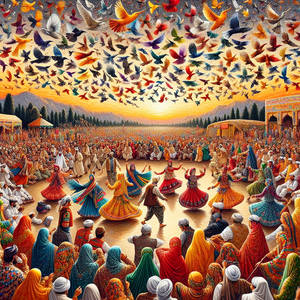Urban Wildlife Wonders: The Resilient Creatures Thriving in Our Cities

Urban environments present a myriad of challenges for wildlife. From noise pollution and light pollution to habitat fragmentation and the constant presence of humans, these creatures must navigate a landscape that is vastly different from their natural habitats. Yet, many species have demonstrated incredible adaptability.
Birds of Prey in the Concrete Jungle
Take, for instance, the red-tailed hawk, which has become a familiar sight in cities such as New York and Chicago. These birds have learned to nest on skyscrapers and hunt in urban parks, taking advantage of the abundance of pigeons and rats. Their keen eyesight allows them to spot prey from great heights, turning urban landscapes into hunting grounds.
Raccoons: The Urban Bandits
Raccoons, once primarily nocturnal creatures, have adapted to a more flexible schedule, often scavenging for food during the day when human activity is at its peak. Their dexterous front paws enable them to open trash cans and access food sources that other animals cannot. This adaptability has not only helped raccoons survive but thrive in urban settings, often becoming a common sight in neighborhoods and parks.
Stories of Resilience
One of the most inspiring aspects of urban wildlife is their resilience in the face of adversity. In cities like San Francisco, the Western gull has adapted to the human environment by utilizing refuse as a food source. These birds have become proficient at foraging in trash bins, showcasing their intelligence and resourcefulness. Their ability to thrive in environments altered by humans is a powerful reminder of nature's tenacity.
Coyotes in the City
Another remarkable example is the coyote, which has made a surprising comeback in urban areas across North America. Once pushed to the outskirts of cities, coyotes are now often spotted roaming through parks and even residential neighborhoods. Their adaptability to urban landscapes has made them a symbol of resilience, demonstrating how wildlife can thrive even when faced with significant challenges. Coyotes have learned to navigate the risks posed by vehicles and human activity, often using green spaces as corridors to move through urban environments.
Surprising Biodiversity in Metropolitan Areas
Urban environments are often perceived as barren landscapes devoid of nature. However, they can be surprisingly rich in biodiversity. Studies have shown that cities can host a wide variety of species, including birds, mammals, insects, and even plants. For example, a study conducted in Toronto found over 200 species of birds nesting in the city, including migratory species that use urban green spaces as stopover points during their journeys.
Green Spaces as Biodiversity Hubs
Moreover, community gardens and green roofs are becoming increasingly popular in urban settings, providing habitats for various species. These green spaces not only enhance the aesthetic appeal of cities but also support local biodiversity, creating a thriving ecosystem amid concrete and steel. Urban parks, such as Central Park in New York City, serve as vital refuges for wildlife, helping sustain populations of both native and migratory species.
The Importance of Urban Wildlife Conservation
Understanding the adaptations and resilience of urban wildlife is crucial for conservation efforts. As cities grow, it is essential to integrate wildlife-friendly practices into urban planning. This can include creating more green spaces, preserving natural habitats, and implementing policies that protect urban biodiversity.
Community Engagement and Stewardship
Community engagement is also vital in fostering a sense of stewardship for urban wildlife. Initiatives such as citizen science programs allow residents to contribute to wildlife monitoring and conservation efforts, helping to raise awareness about the importance of coexistence between humans and wildlife. Programs that encourage residents to plant native species in their gardens or participate in local wildlife surveys can enhance urban biodiversity and foster a deeper connection to the natural world.
Urban wildlife is a testament to nature's resilience and adaptability. As we continue to urbanize and reshape our environments, it is essential to recognize and celebrate the unique creatures that have found a way to thrive alongside us. By understanding their adaptations, sharing inspiring stories of resilience, and advocating for conservation efforts, we can create cities that not only accommodate human life but also support and nurture the incredible biodiversity that enriches our urban landscapes. Embracing urban wildlife is not just about appreciating nature; it's about fostering a harmonious relationship between humans and the natural world in our ever-evolving cities. As we move forward, let us strive to create urban spaces that honor and protect the resilience of the wildlife that calls them home.
Urban Wildlife Biologist
Non-profit conservation organizations, government agencies, universities
Core Responsibilities
Conduct research on urban wildlife populations and their behaviors to understand adaptations to city environments.
Collaborate with urban planners to integrate wildlife conservation strategies into city development projects.
Monitor and assess the health of urban ecosystems and recommend conservation practices.
Required Skills
Strong background in ecology and wildlife biology, with a focus on urban environments.
Proficiency in data analysis and field research methodologies.
Excellent communication skills for outreach and education initiatives.
Urban Ecologist
Environmental consulting firms, academic institutions, city planning departments
Core Responsibilities
Study the interactions between urban ecosystems and wildlife, focusing on biodiversity and habitat fragmentation.
Develop models to predict the impacts of urban development on local wildlife populations.
Advocate for policies that promote sustainable urban growth and biodiversity conservation.
Required Skills
Expertise in ecological modeling and GIS (Geographic Information Systems).
Understanding of urban planning processes and environmental regulations.
Ability to work with diverse stakeholders, including city officials and community groups.
Community Engagement Coordinator for Urban Wildlife Conservation
Non-profit organizations, community development agencies, educational institutions
Core Responsibilities
Design and implement community programs that promote awareness and stewardship of urban wildlife.
Organize workshops, citizen science initiatives, and educational events to engage local residents.
Partner with schools, local organizations, and government bodies to foster community involvement in conservation efforts.
Required Skills
Strong interpersonal and public speaking skills to effectively communicate with diverse audiences.
Experience in community organizing and program development.
Knowledge of urban wildlife issues and conservation strategies.
Wildlife Rehabilitation Specialist
Wildlife rehabilitation centers, animal rescue organizations, zoos
Core Responsibilities
Provide medical care and rehabilitation to injured or orphaned urban wildlife.
Educate the public on coexistence with urban wildlife and the importance of wildlife protection.
Collaborate with local governments and organizations to develop wildlife rescue protocols.
Required Skills
Certification in wildlife rehabilitation and knowledge of veterinary care for various species.
Strong observational skills and the ability to handle wildlife safely.
Experience in public education and outreach.
Urban Green Space Planner
Landscape architecture firms, city parks departments, non-profit environmental organizations
Core Responsibilities
Design and implement urban green spaces that promote biodiversity and enhance habitat for wildlife.
Collaborate with architects and city planners to create landscapes that support both human and wildlife needs.
Conduct assessments of existing green spaces to improve their ecological value.
Required Skills
Strong understanding of landscape architecture and ecological principles.
Proficiency in design software such as AutoCAD and GIS.
Excellent project management skills and experience working with community stakeholders.


